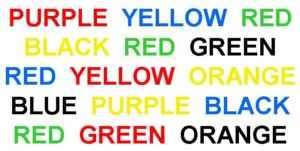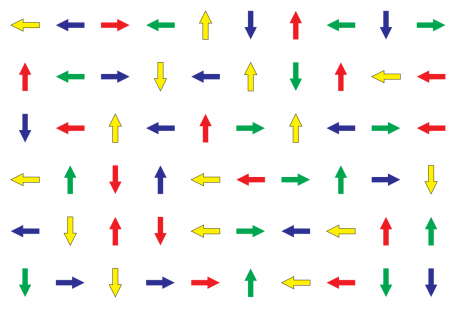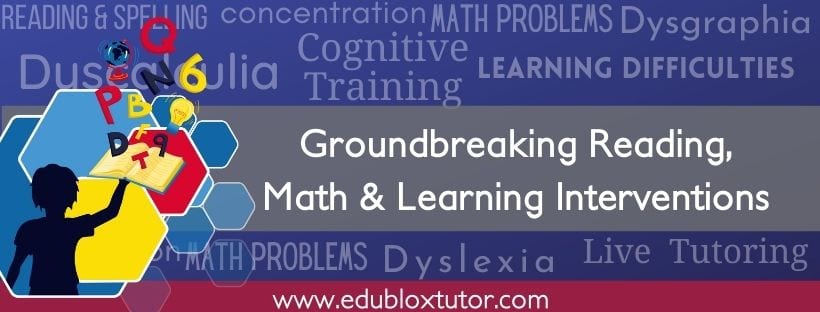
Divided attention is a cognitive skill where you have to attend to multiple sources of information at once, or perform two (or more) tasks simultaneously and attention is required to perform both (or all) tasks.
Examples of divided attention include driving a car while conversing with a passenger or eating dinner while watching the news. If the task is to write a story, a student must be able to think about their characters and plot, as well as spelling and punctuation rules that apply.
Why divided attention matters
When people are required to do more than one task at a time, performance on at least one of the tasks often declines. It is generally agreed that humans have a limited capacity to process information. When several tasks must be performed at the same time, the demands of the tasks may exceed processing capacity.
Research has shown a link between reading difficulties and deficiencies in divided attention. For example, studies have shown that people with dyslexia make more errors and need more time on Stroop tasks than non-dyslexics.
In psychology, the Stroop effect refers to a phenomenon whereby it is easier to say the color of a word if it matches the semantic meaning of the word. For example, when the name of a color (e.g., “blue,” “green,” or “red”) is printed in a color not denoted by the name (e.g., the word “red” printed in blue ink instead of red ink), naming the color of the word takes longer and is more prone to errors than when the color of the ink matches the name of the color. Stroop tasks are commonly used to measure divided attention.

How to improve divided attention
The good news is that divided attention can be improved with practice. Spelke, Hirst, and Neisser studied the accuracy and response time of performance by participants reading short stories and writing down dictated words. The participants’ initial performance was very poor when both tasks were performed simultaneously. But, after the participants practiced the tasks five days a week for 85 sessions, their performance in both tasks improved.
When doing cognitive skills training, it is essential to note that such training should be multi-cognitive. In physical training, a balanced workout is vital as overtraining one part of the body can cause deformity, such as Popeye syndrome when overtraining the biceps. The brain is no different. For example, in Maguire et al.’s experiment with London taxi drivers, growth in the posterior hippocampi seems to have come at a cost, as they had reduced anterior hippocampal gray matter volume compared with bus drivers, with anterior volume decreasing with more navigation experience (Maguire et al., 2006).
One should also consider the role of mutualism. A mutualistic view suggests that cognitive abilities mutually facilitate growth. For example, better reasoning skills allow individuals to improve their vocabulary more quickly, and better vocabulary is associated with faster improvement in reasoning ability (Kievit et al., 2017).
Therefore, in addition to doing Edublox’s Development Tutor program four to five times a week for 15-20 minutes per session, the following exercise, “Arrows with a Twist,” can be done for 2-3 minutes.
Divided attention exercise
Do Edublox’s Development Tutor program for 15-20 minutes (3 exercises equal a session). After that, do “Arrows with a Twist” for 2-3 minutes. This exercise consists of six levels and develops various skills such as directionality, sequencing, rapid naming, and divided attention. Copyright: Edublox (Pty) Ltd.
Level 1
The tutor (or parent) needs the arrow chart for this exercise (scroll down to the bottom of this page to download the arrows chart). The arrows are printed in four colors and point in four directions: up, down, left, and right.
The tutor must fix the arrows chart to the wall so the student can look at it directly. Next, the student must stand upright and call out the colour of each arrow, starting with the top left arrow through to the bottom right arrow. Finally, the tutor must turn the chart 90 degrees before asking the student to call out the colors again.
The student must do this exercise at a relaxed and leisurely pace. Do not let them rush through them. One should aim at a greater speed only when they start getting comfortable with the exercise.
Proceed to Level 2, when the student can call out the colors on the whole chart quickly and fluently, without any hesitations or mistakes.
Level 2
The tutor must fix the arrows chart to the wall so the student can look at it directly. Next, the student must stand upright, with their clenched fists held at their shoulders (or fingers on their shoulders). The student must “read” the arrows one after the other, simultaneously announcing the direction in which each arrow is pointing and pushing out their fists (or fingers if they prefer an open hand) in the direction so announced.
This means that if the student starts “reading” the arrows, they will shoot the left fist towards the left while simultaneously calling out, “Left!”
The student must immediately return their left fist to the shoulder, ready to “read” the next arrow. This means they will reshoot the left fist, saying, “Left!” Again, they must bring the left fist back to the shoulder immediately. Then they must “read” the third arrow. Next, they must shoot the right fist to the right and say, “Right!” The right fist is also brought back to the shoulder immediately, and then the direction of the next arrow is announced. The left fist is pushed out again while the student says, “Left!” To “read” the next arrow, the student must shoot both fists above the head, simultaneously announcing, “Up!” Both fists are brought back to the shoulders, ready to “read” the next arrow, “Down!”
In this way, the student must read through the whole chart from top to bottom. Then, the tutor must turn the chart 90 degrees before asking the student to read it again.
The student must use their fist to indicate the direction in which each arrow is pointing while simultaneously announcing the direction. Left and right are shown with one fist, whereas up and down are shown with both. The tutor must check that the student does everything correctly.
Proceed to Level 3, when the student can read the whole chart quickly and fluently, without hesitation or mistakes.
Level 3
The student must now call out the color of every red and yellow arrow but the direction of every green and blue arrow, simultaneously pushing out their fist(s) when “reading” the green and blue arrows.
Proceed to Level 4, when the student can read the whole chart quickly and fluently, without hesitation or mistakes.
Level 4
Repeat Levels 1 through 3. This time, however, the student must march on the spot while “reading” the arrows. They must call out the color or announce the direction of each arrow, synchronizing it with each step of the left foot.
- First, they must march on the spot while calling out the color of each arrow, synchronizing it with each step of the left foot.
- Once the student can do this quickly and fluently, they must, while marching, read the arrows one after the other, simultaneously announcing the direction in which each arrow is pointing and pushing out their fist(s) in the direction so announced.
- Once the student can do this quickly and fluently, they must, while marching, call out the color of every red and yellow arrow but the direction of every green and blue arrow, simultaneously pushing out their fist(s) when reading the green and blue arrows.
Level 5
Repeat Levels 1 through 3. This time, however, the student must march on the spot while “reading” the arrows. They must call out the color or announce the direction of each arrow, synchronizing it with each step of the right foot.
- First, they must march on the spot while calling out the color of each arrow, synchronizing it with each step of the right foot.
- Once the student can do this quickly and fluently, they must, while marching, read the arrows one after the other, simultaneously announcing the direction in which each arrow is pointing and pushing out their fist(s) in the direction so announced.
- Once the student can do this quickly and fluently, they must, while marching, call out the color of every red and yellow arrow but the direction of every green and blue arrow, simultaneously pushing out their fist(s) when reading the green and blue arrows.
Level 6
Repeat Levels 1 through 3. This time, however, the student must march on the spot while “reading” the arrows. They must call out the color or announce the direction of each arrow, synchronizing it with each step of both feet.
- First, they must march on the spot while calling out the color of each arrow, synchronizing it with each step of both feet.
- Once the student can do this quickly and fluently, they must, while marching, read the arrows one after the other, simultaneously announcing the direction in which each arrow is pointing and pushing out their fist(s) in the direction so announced.
- Once the student can do this quickly and fluently, they must, while marching, call out the color of every red and yellow arrow but the direction of every green and blue arrow, simultaneously pushing out their fist(s) when reading the green and blue arrows.
Click to download!
@ Edublox (Pty) Ltd.


